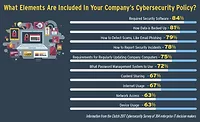Workplace Emergency Planning is Shifting, But Employees Don't Feel It's a Priority

The 2019 Workplace Safety and Preparedness Survey from Rave Mobile Safety discusses the latest state of safety in the corporate environment, as well as what communication changes companies have made and what shortcomings still exist from the last year. The survey found that almost 50 percent of respondents have experienced a severe weather emergency, though more than 47 percent of those surveyed rarely or never tested emergency drills to be better prepared for the events.
"The survey gives great insight into how employees feel about their level of safety at work in the event of a possible emergency situation, but also demonstrates the disconnect that still exists between the communications channels employers use to inform their employees during emergencies and the way employees prefer to receive this information," said Todd Piett, CEO of Rave Mobile Safety. "This year's survey continues to emphasize that more needs to be done to drive safety awareness in an organization's everyday operations. Employers must also examine how they can bridge the gap between preparedness plans and the drills in place and realities of what their workers could encounter while on the job."
Additional key findings from the survey include:
Organizations are still not focusing enough on overall emergency preparedness and drills
When asked how often their employer performs drills or tests emergency plans for different situations, 53 percent answered "never" for workplace violence situations, 45 percent answered "never" for medical emergencies, 50 percent answered "never" in the case of hazardous materials incidents, and 55 percent answered "never" for system outages and cyberattacks.
However, the research also found that with regard to fire-related emergencies, 80 percent of respondents claimed that their organizations perform drills or test emergency plans for this situation.
Mobile communication has progressed as the top method for critical communications in the past year
The survey results show that mobile communication is rapidly becoming the communication method of choice for emergency situations. Over the last year, text messages continued to grow as a communication method, increasing from 44 percent in current use to 50 percent who prefer text messages. In addition, the findings show mobile apps growing from 10 percent to 16 percent as a current communication method in place from 2018 to 2019.
"Keeping employees safe and informed about all kinds of workplace emergencies is an organization's top priority," said Don Aviv, president of Interfor International, a global investigation and security consulting firm. "Given the current landscape, organizations need to continue to make strides to communicate with how their employees' prefer, as well as offer them tools to improve their safety."
Traditional methods of emergency communication are in rapid decline from 2018 to 2019
The survey found that while employers are increasingly embracing mobile technology for emergency situations, the usage of phone trees and automated voicemail (down 16 percent from 2018 to 2019) and intercom system announcements and building alarms (down 22 percent from 2018 to 2019) both declined.
Email is still the most common method of emergency communication used by 55 percent of employers. However, email lags behind text messages in terms of preference with only 11 percent of respondents citing it as their preferred method of communication.
Looking for a reprint of this article?
From high-res PDFs to custom plaques, order your copy today!






